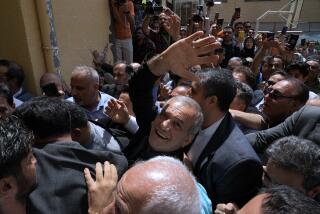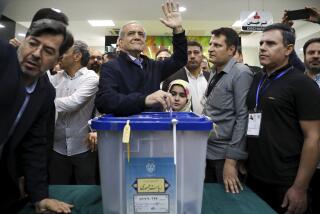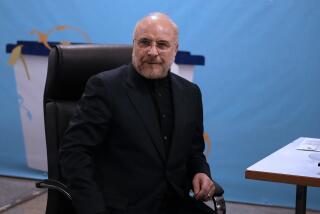NEWS ANALYSIS : Iran Faces Key Challenges at Home, Abroad
- Share via
WASHINGTON — The death of the Ayatollah Ruhollah Khomeini presents Iran’s Islamic revolution with political challenges, both internal and external, potentially more ominous than any it has faced in the decade since the ouster of the shah.
For all the purges, infighting and executions that marked the Khomeini epoch, according to U.S. analysts and Iran specialists, the immediate post-Khomeini period may turn out to be even more divisive.
Over the weekend, several opposition groups vowed to wage new military and political campaigns and openly predicted the collapse of the 20th Century’s only theocracy. “We are going to witness the downfall of the regime in the near future,” claimed Aladdin Touran, spokesman for the Moujahedeen, or Holy Warriors.
And Reza Pahlavi, who crowned himself shah shortly after his father’s death in exile in 1980, said, “The Islamic Republic is dead with the passing away of Khomeini.”
Yet in contrast to the early 1980s, when Islamic fundamentalists were relatively united against challenges from leftist, secular and monarchical groups, the challenges facing the revolutionary cadre now are likely to pit the mullahs, or clergy members, against themselves.
Now they must finally confront the disputes that have stalemated movement on key economic and political issues for almost six years--since major opposition groups were largely eliminated inside Iran.
If the revolution is to survive, specialists generally agree, it will have to act on two broad issues: domestically, loosening the revolution’s draconian grip on society and, in foreign affairs, coming to terms with the outside world.
“Short-term, Iran is likely to witness great tension and uncertainty. What we have seen of the power struggle so far may seem insignificant in comparison with what lies ahead,” said one U.S. analyst. “But long-term, the government will have to become more realistic and more tolerant if it hopes to survive.
Breaking Point
“For one thing, it no longer has Khomeini’s magic to provide cohesion. For another, its problems have reached the breaking point.”
Khomeini’s absence is likely to be most deeply felt on the issue of national unity. While he antagonized much of the outside world, he was, in fact, the conciliator in keeping rivals under the same political roof at home.
“One of the key roles that Khomeini always played was to act as a mediator, as an intermediary between the various warring factions,” said Gary Sick, the National Security Council official in charge of Iran during the Carter Administration. “Now that he is gone, there is nobody to stand between those factions.”
The divisions among so-called pragmatists and hard-liners are so entrenched that the Islamic Republic’s first president, Abolhassan Bani-Sadr, predicted from his exile in Paris that Iran might be engulfed in a civil war as bloody as Lebanon’s strife.
“The people who are the remnants of Khomeini’s government and regime are not people with the authority to issue decrees from the Islamic vantage point. Technically today, the regime is no longer an Islamic republic,” Pahlavi said on ABC’s “This Week with David Brinkley.”
Rebel Claims
And the Moujahedeen’s Touran told The Times that the Moujahedeen’s National Liberation Army, which is based in Iraq, would launch a military assault on Iran. The Moujahedeen, an Islamic Marxist group, made its first military gains in the final stages of the Iran-Iraq War in 1988. It claims to have increased its combat ability by 50% in the past four months in preparation for a final confrontation with Tehran’s clerics.
Tehran’s political spectrum is labyrinthine and often complicated by clan and business intrigue. But, in simple terms, it pits those favoring gradual reforms at home combined with better relations with the outside world against others determined to endure sacrifice in the name of revolutionary purity.
At the same time, however, the theocracy’s swift selection of at least a temporary successor, President Ali Khamenei, within 24 hours of the imam’s death may calm fears of instability and violence.
A senior State Department official expressed “a certain amount of admiration” that the mullahs so quickly agreed on a new leader.
Organized Quickly
“Either they were able to get organized more quickly than outsiders thought possible or they had gone a long way toward consolidating things already,” he commented.
The widespread consensus among U.S. intelligence and State Department officials has been that no single figure would be able to replace Khomeini. The prevalent analysis had predicted that he would be replaced by a council of three to five senior clerics, which Iran’s constitution provides as an alternative.
Winning agreement on the members of such a council might have only further entrenched the divisions, since the major factions would each have insisted on representation. While Khamenei’s role is likely, at least short-term, to be more ceremonial than authoritative, a single well-known figure at the helm may help alleviate public anxiety in the short-term.
The next three months will be crucial in determining the leadership and shape of post-Khomeini Iran, and whether the revolution can survive without the charismatic authoritarian who pulled off one of the greatest political feats of the century.
Self-Imposed Timetable
In effect, the Islamic Republic has a self-imposed timetable to sort through several political issues because of presidential elections, scheduled before the imam’s passing, in mid-August.
One of the few similarities between Iran and the United States is that presidents are limited to two terms. Khamenei’s second term expires this year.
In large part because of the deadlocks created by the power struggle, a movement was launched earlier this year to strengthen the presidency and to streamline the cumbersome policy-making apparatus in other branches of government. In the run-up to the election, a special assembly of religious and political experts was enmeshed in outlining the first amendments to the Islamic Republic’s constitution.
The changes were widely expected to pave the way for Speaker of Parliament Hashemi Rafsanjani to become Iran’s first executive president. Although he has long been the de facto second-in-command, his attempts at pragmatic reform have been repeatedly blocked by both more conservative and more radical internal opposition.
Economic Hardship
The pressures for political change and for solutions to growing economic hardships were reaching crisis proportions. They were also beginning to threaten public support for the revolution. The two-step plan this summer was designed to break the logjam.
Khomeini’s passing, however, could not have come at a worse time for Iran, State Department sources said. All major initiatives required the imam’s imprimatur to win endorsement. Without him, they predicted, the constitutional changes now being debated and the presidential contest could well become the focal points for an escalating internal clash.
“Even if they recognize they must pull together after Khomeini’s death, we’re going to see a lot of factionalism for quite a long time,” said Shaul Bakhash, an Iranian-born professor of history at George Mason University and author of “The Reign of the Ayatollahs.”
Western hopes of an imminent turn in Iranian foreign policy after Khomeini’s death are also unlikely, Iran specialists said, particularly on terrorism and an opening up to the West.
Renewal of Relations
“The prospects for renewal of relations with the United States or the release of the nine American hostages (held by pro-Iranian groups in Lebanon) remain as remote as ever,” said one American analyst.
“While a power struggle looms, every leader and every contender will try to appear more militant than anyone else, in keeping with Khomeini’s last edicts.”
In many ways, the imam’s final orders are as important as his last will and testament, which was read Sunday in Tehran, in setting the tone for the immediate future. Although he reluctantly agreed to a cease-fire with Iraq last summer and subsequently relaxed societal bans on music, chess and theater last fall, his tone turned hard again this spring.
His “death sentence” in February on Salman Rushdie, author of “The Satanic Verses,” and the firing of his heir apparent in March were followed by public condemnations of “liberals” who were selling out the revolution to Western interests.
More to Read
Sign up for Essential California
The most important California stories and recommendations in your inbox every morning.
You may occasionally receive promotional content from the Los Angeles Times.













